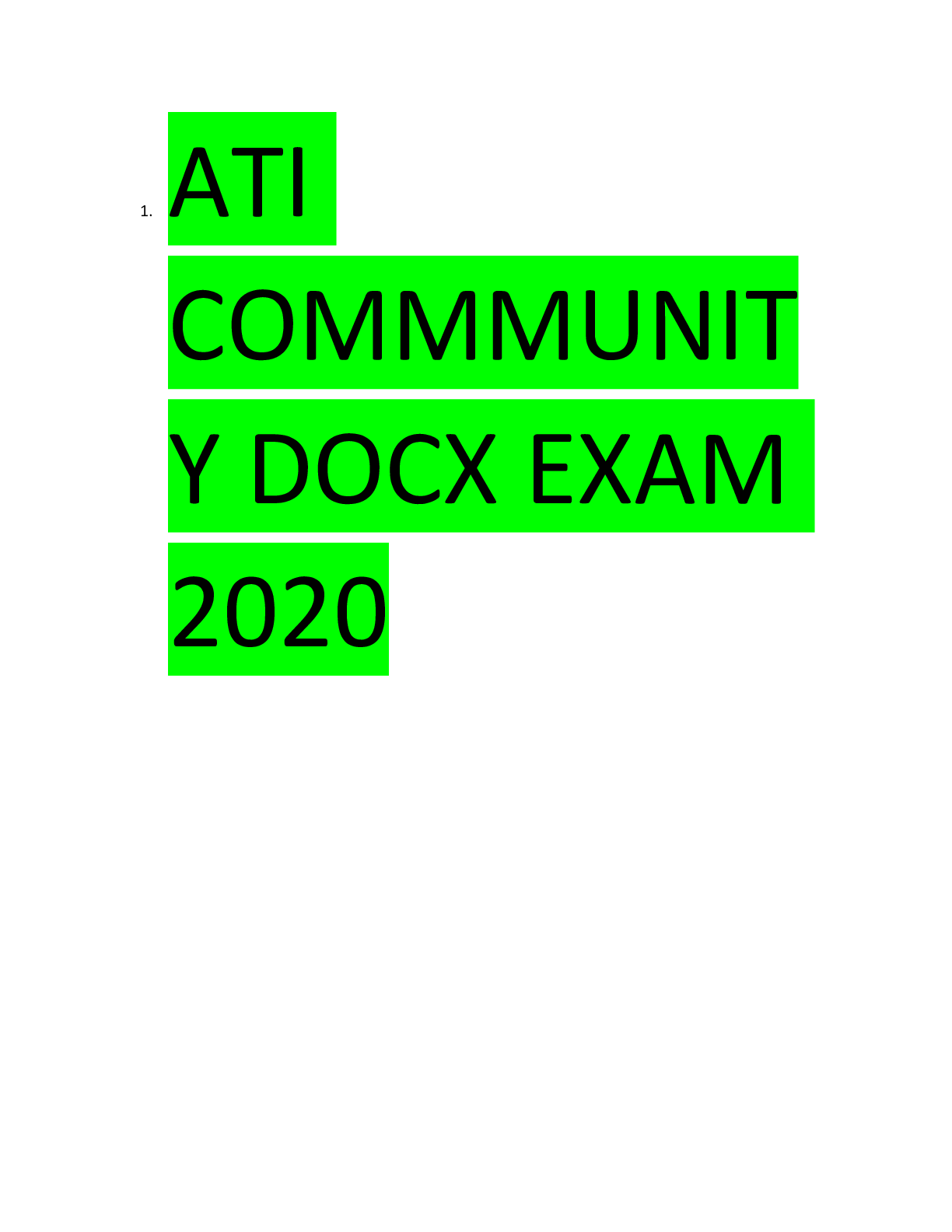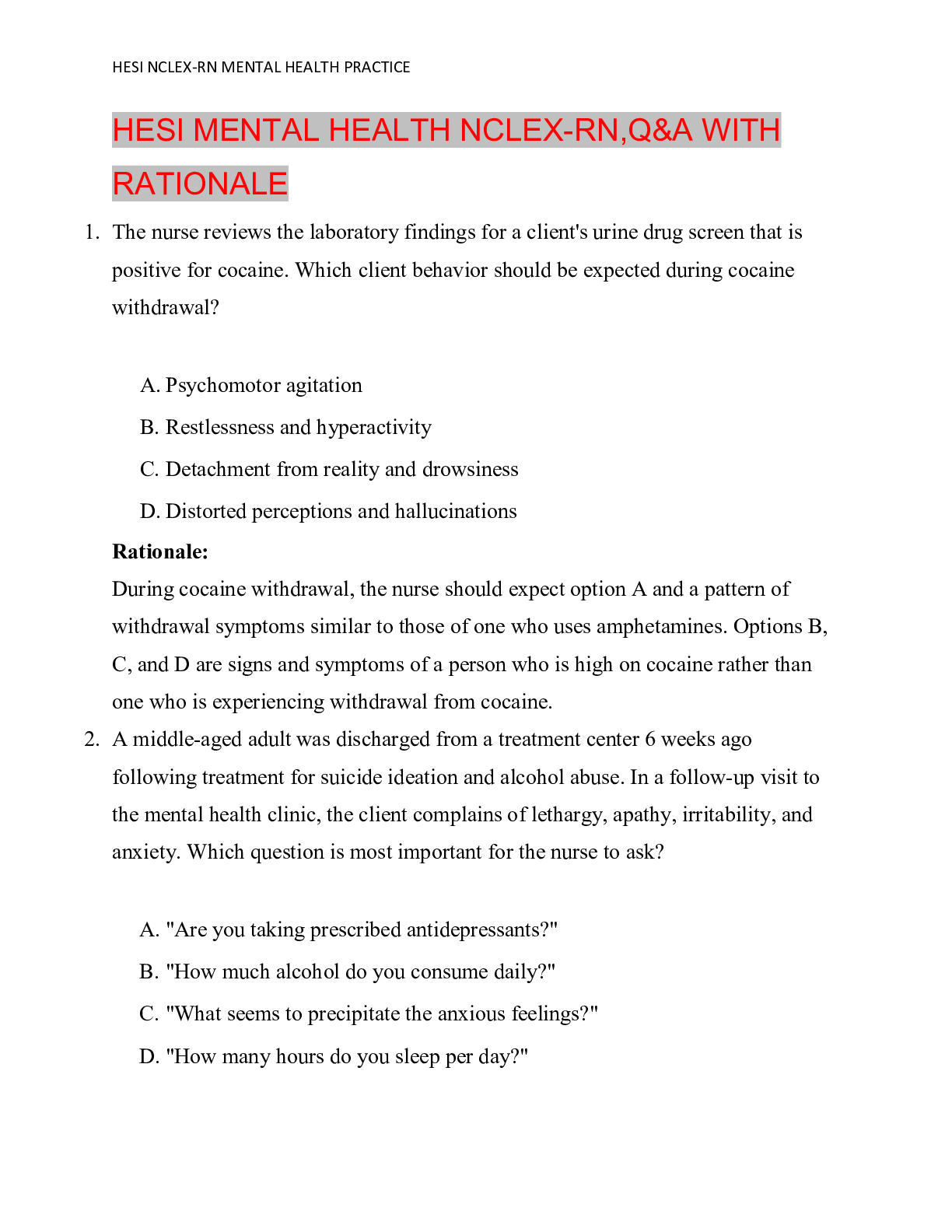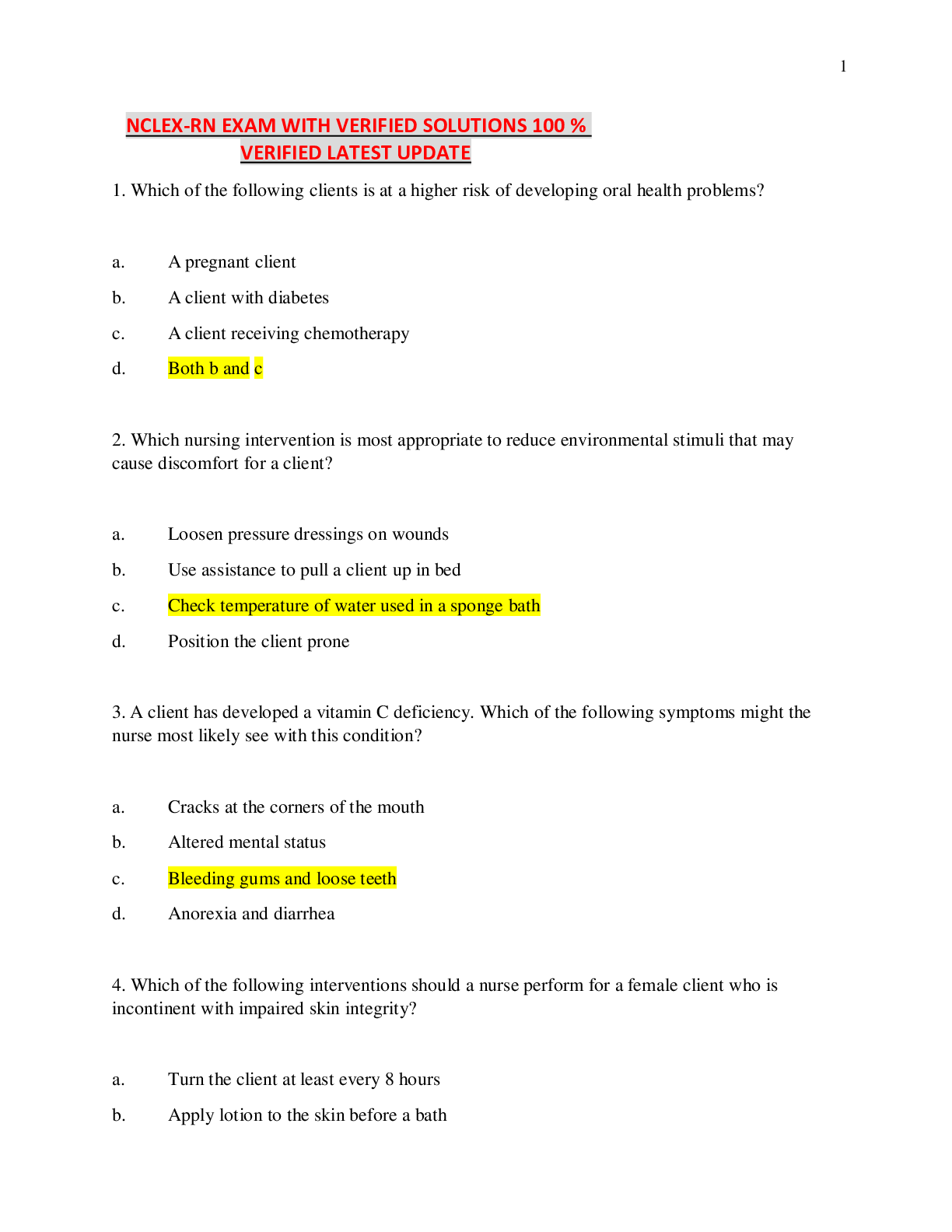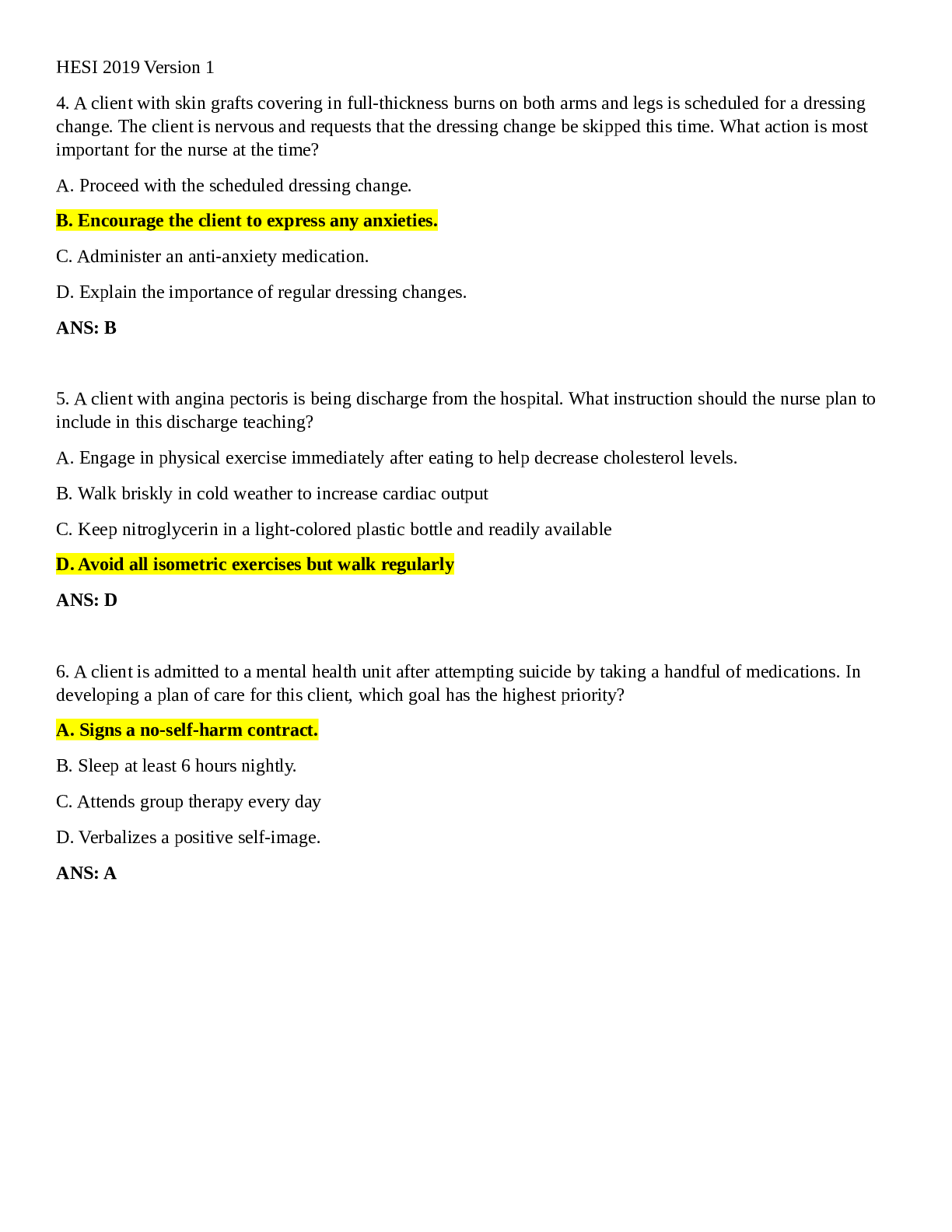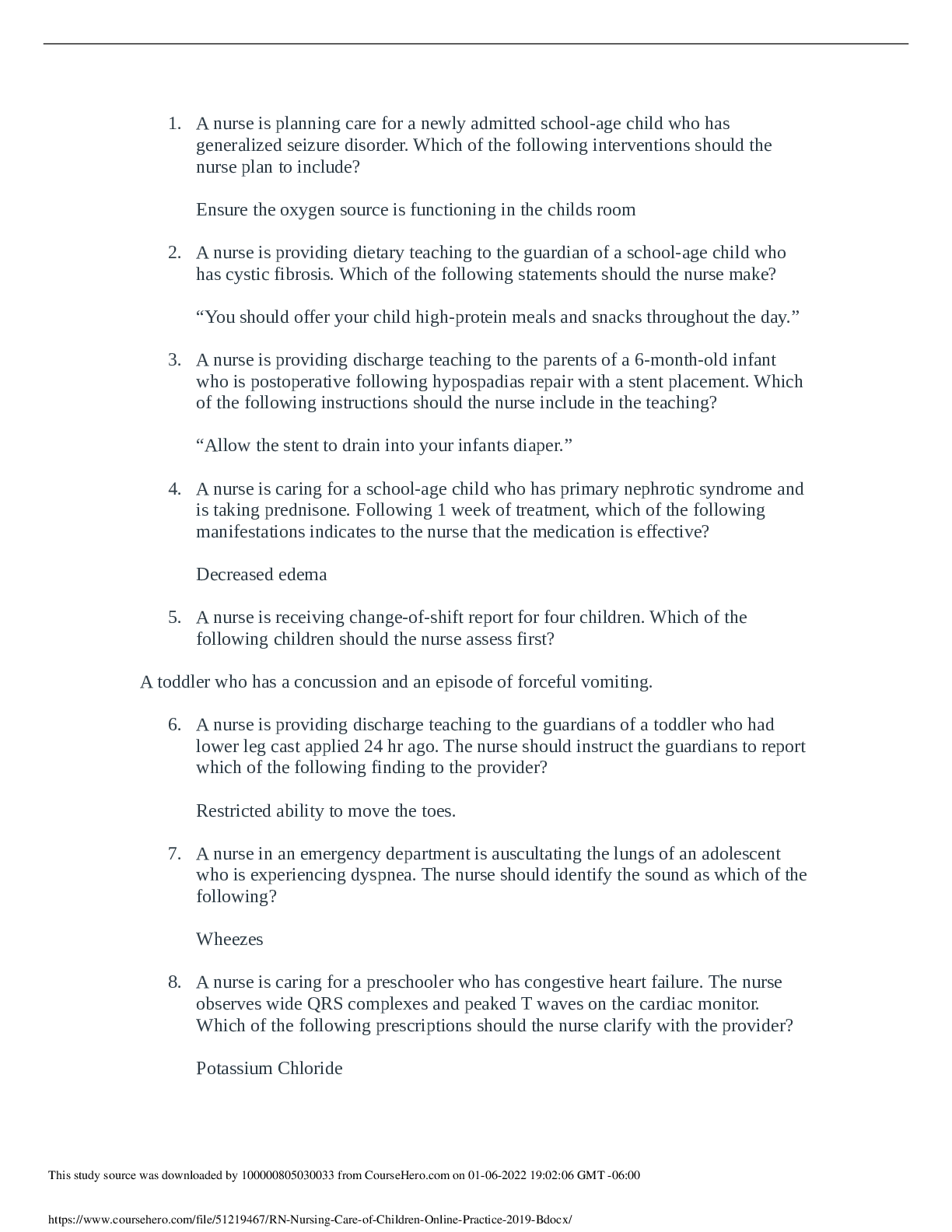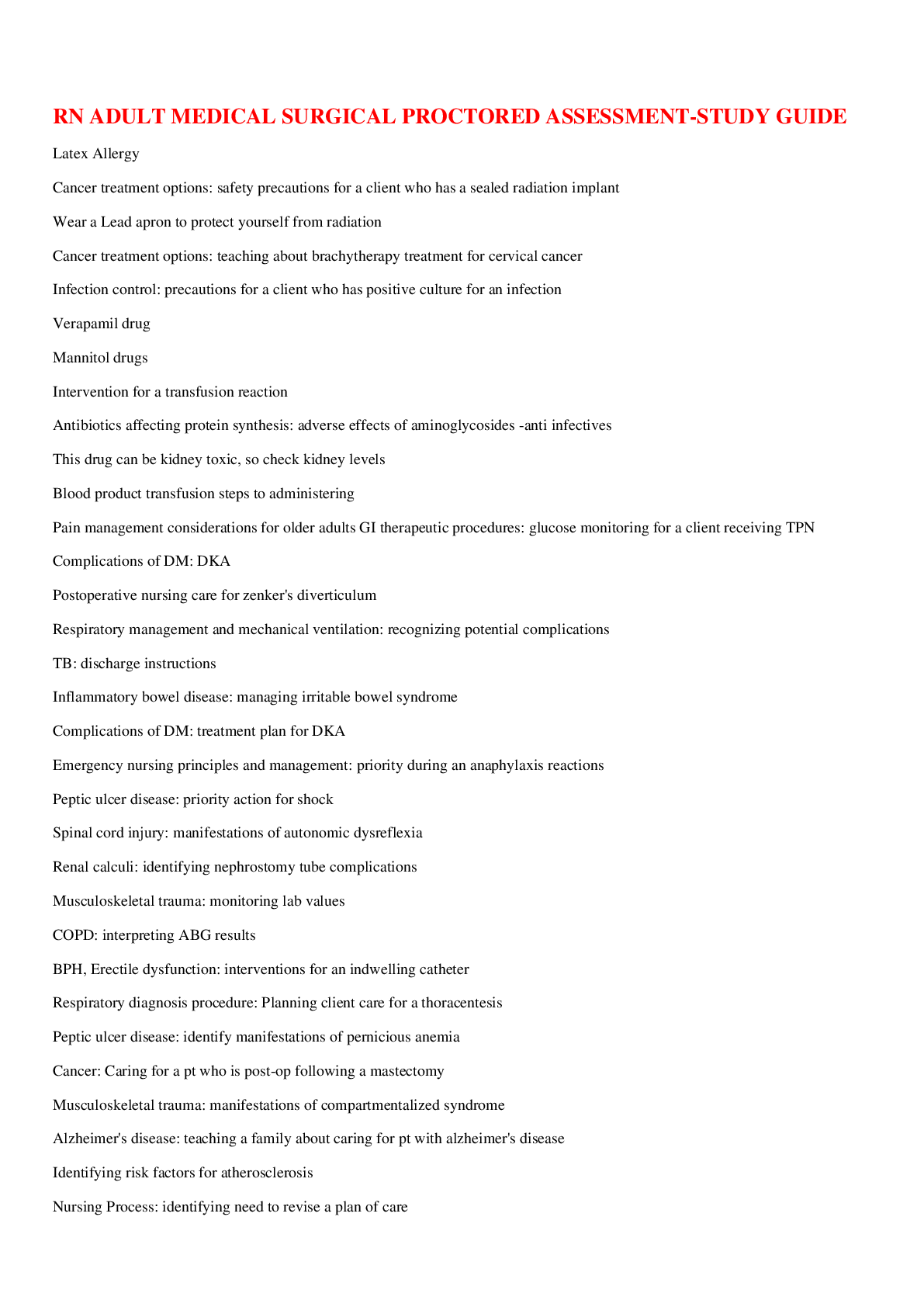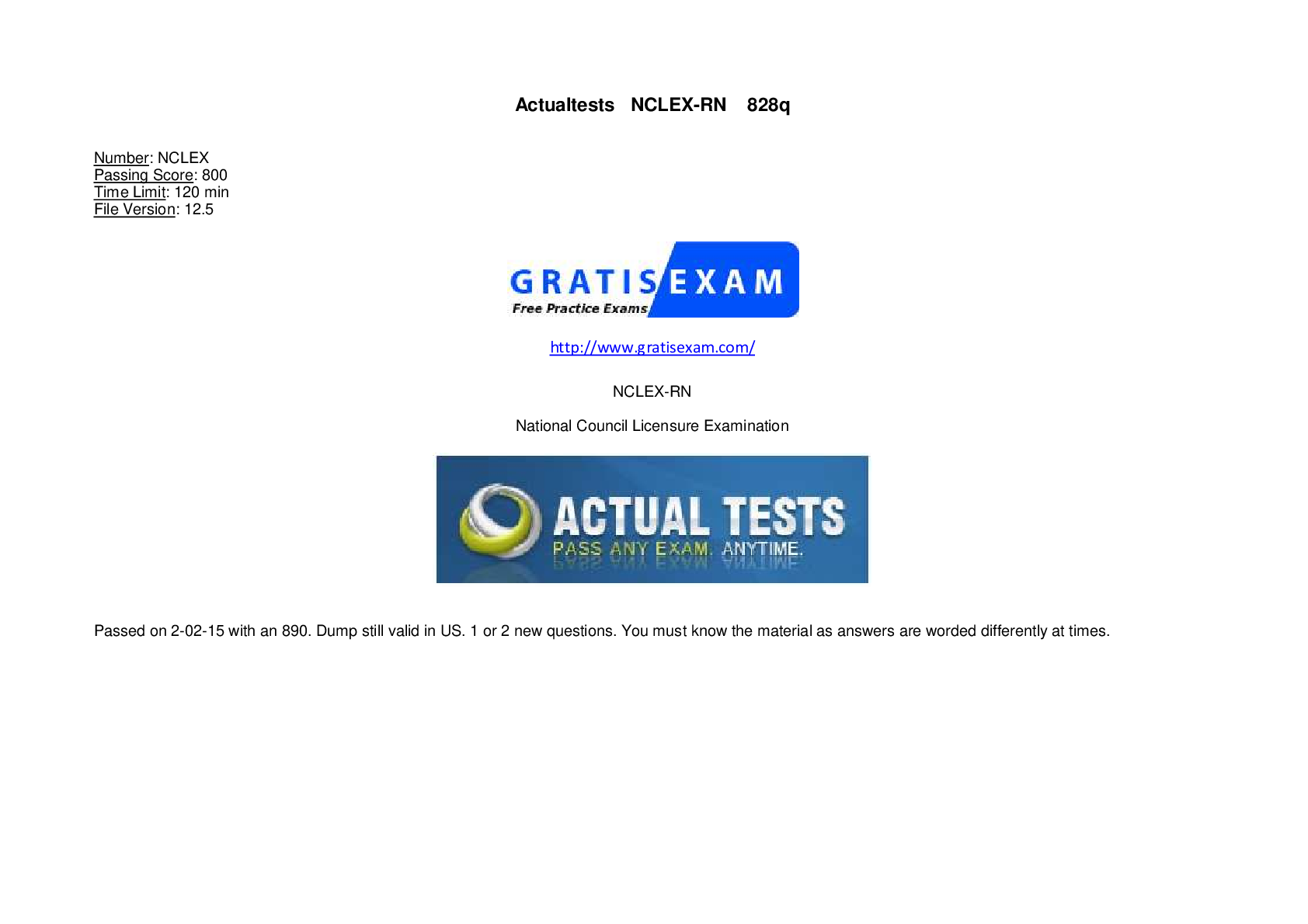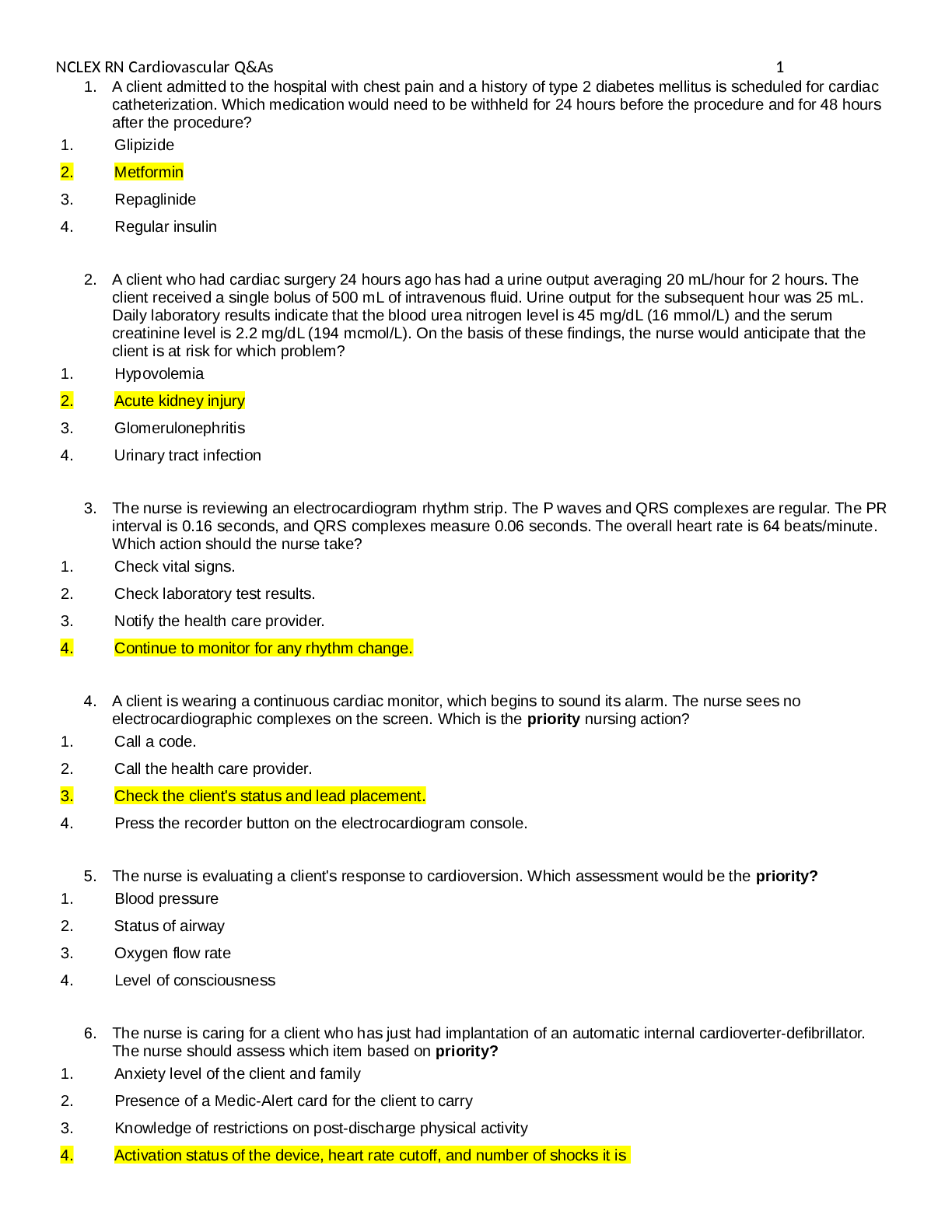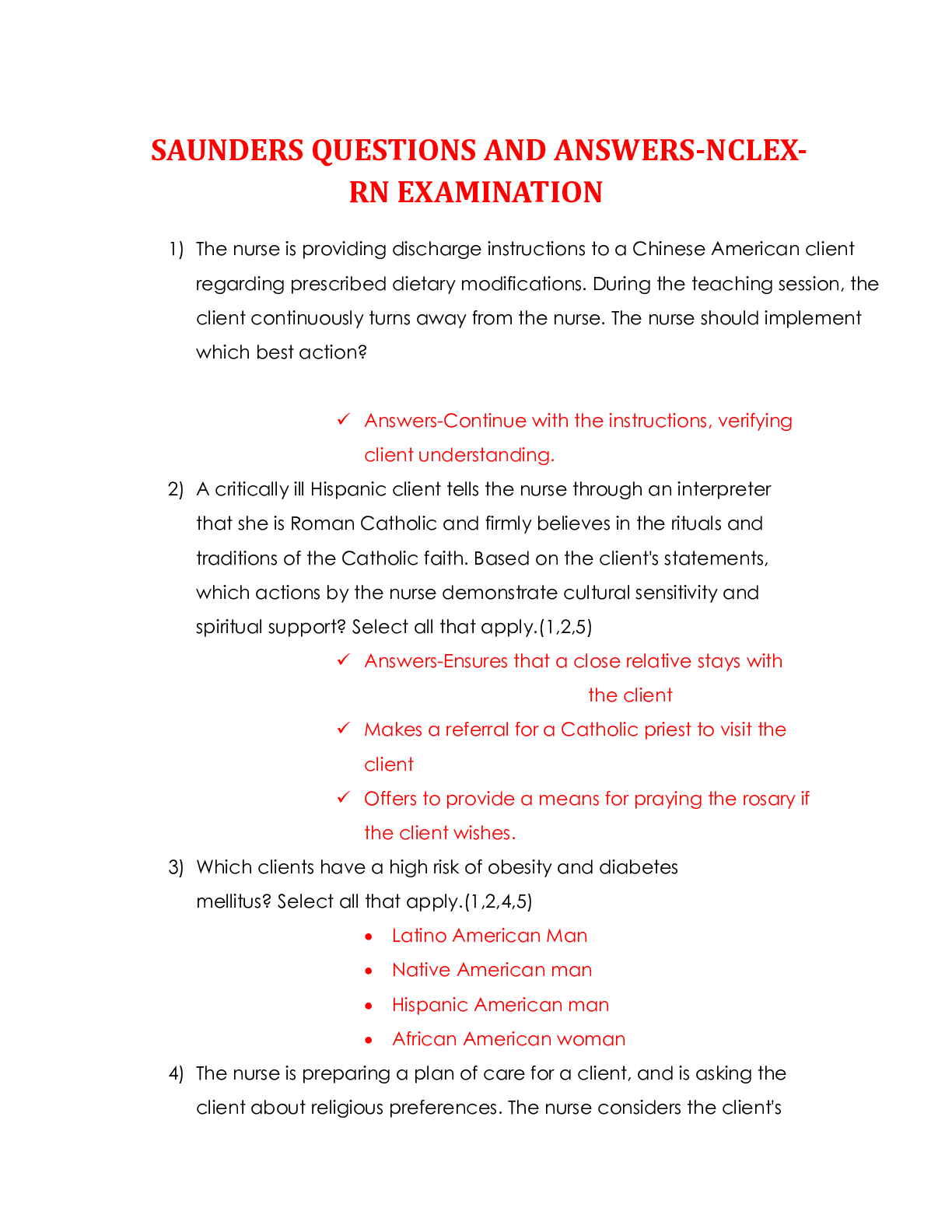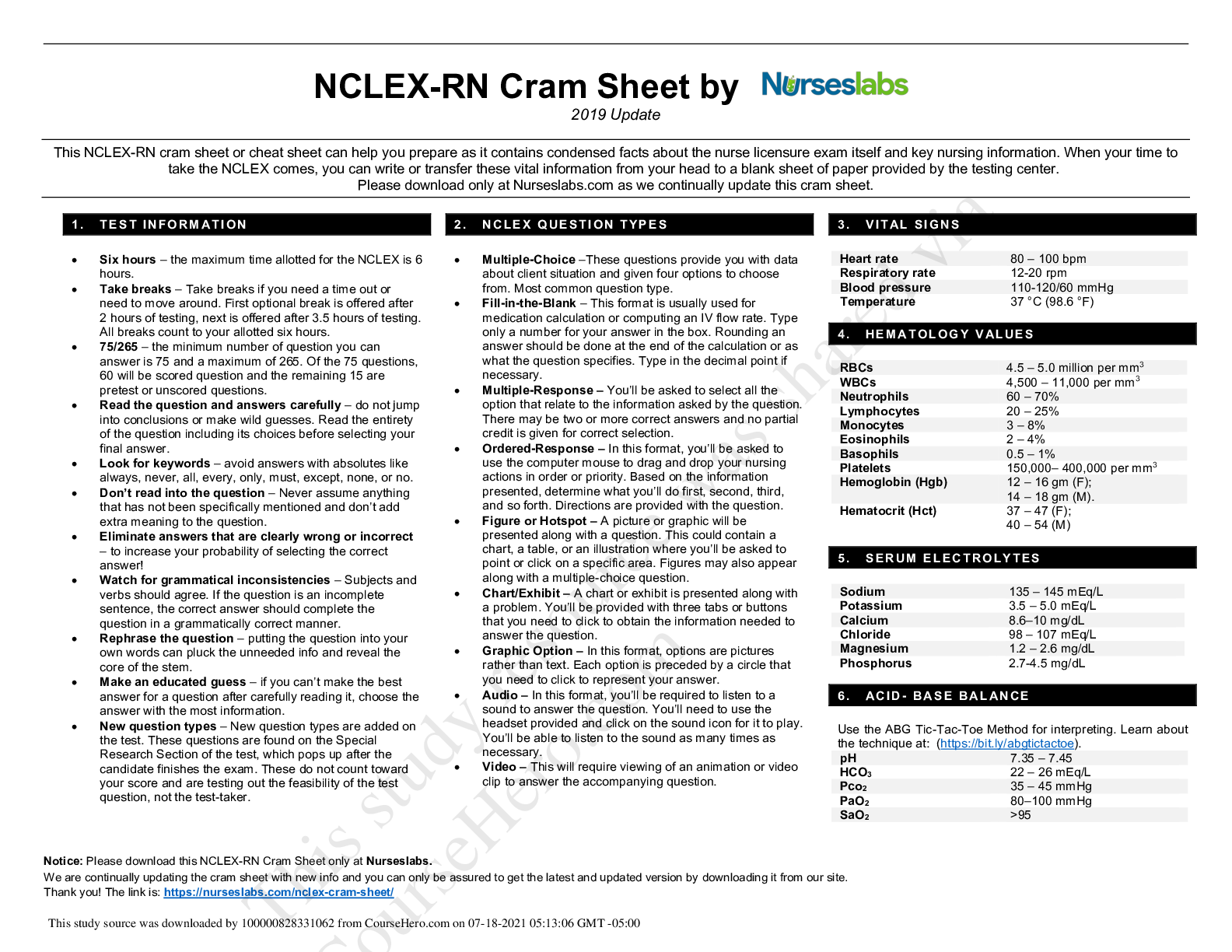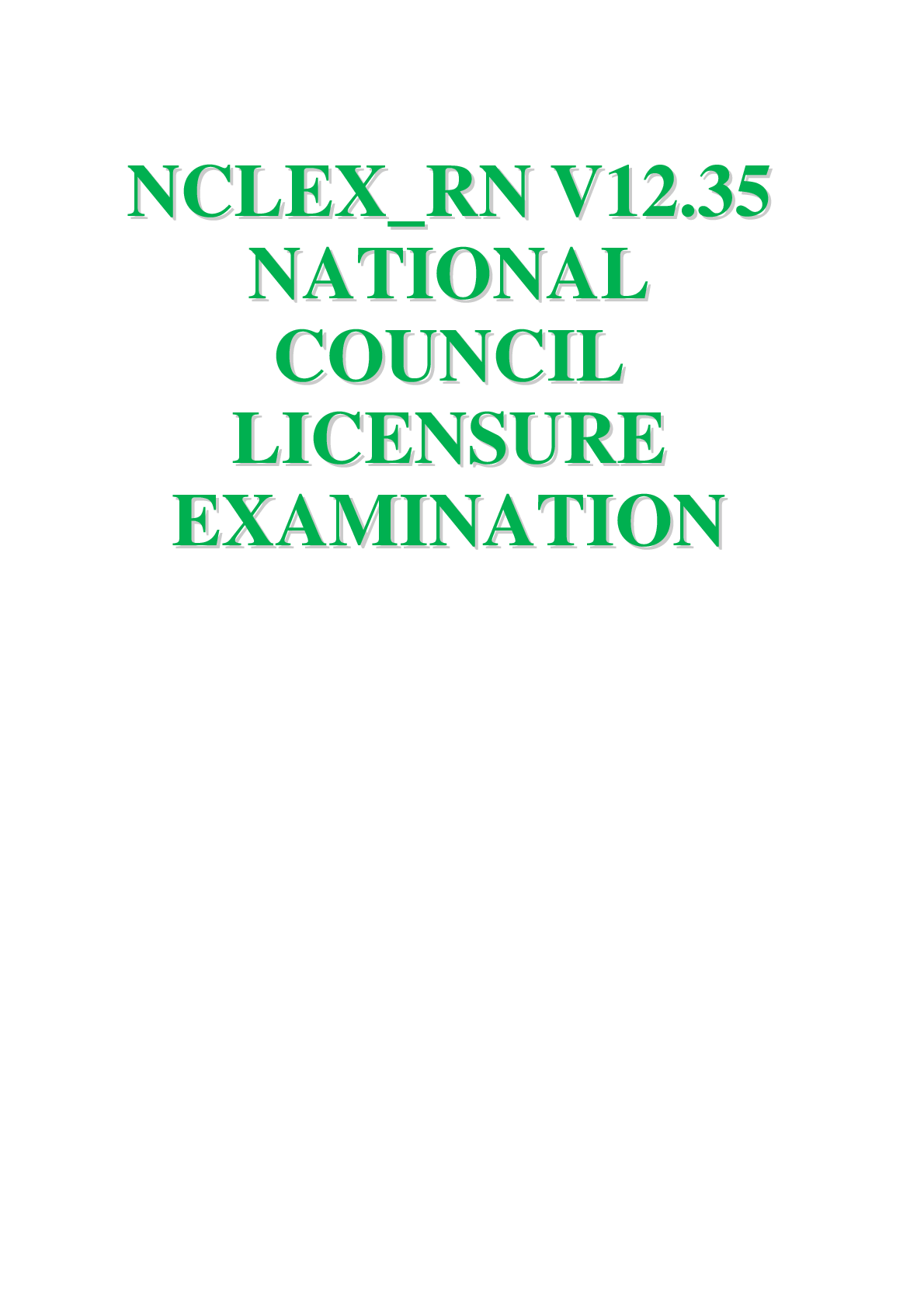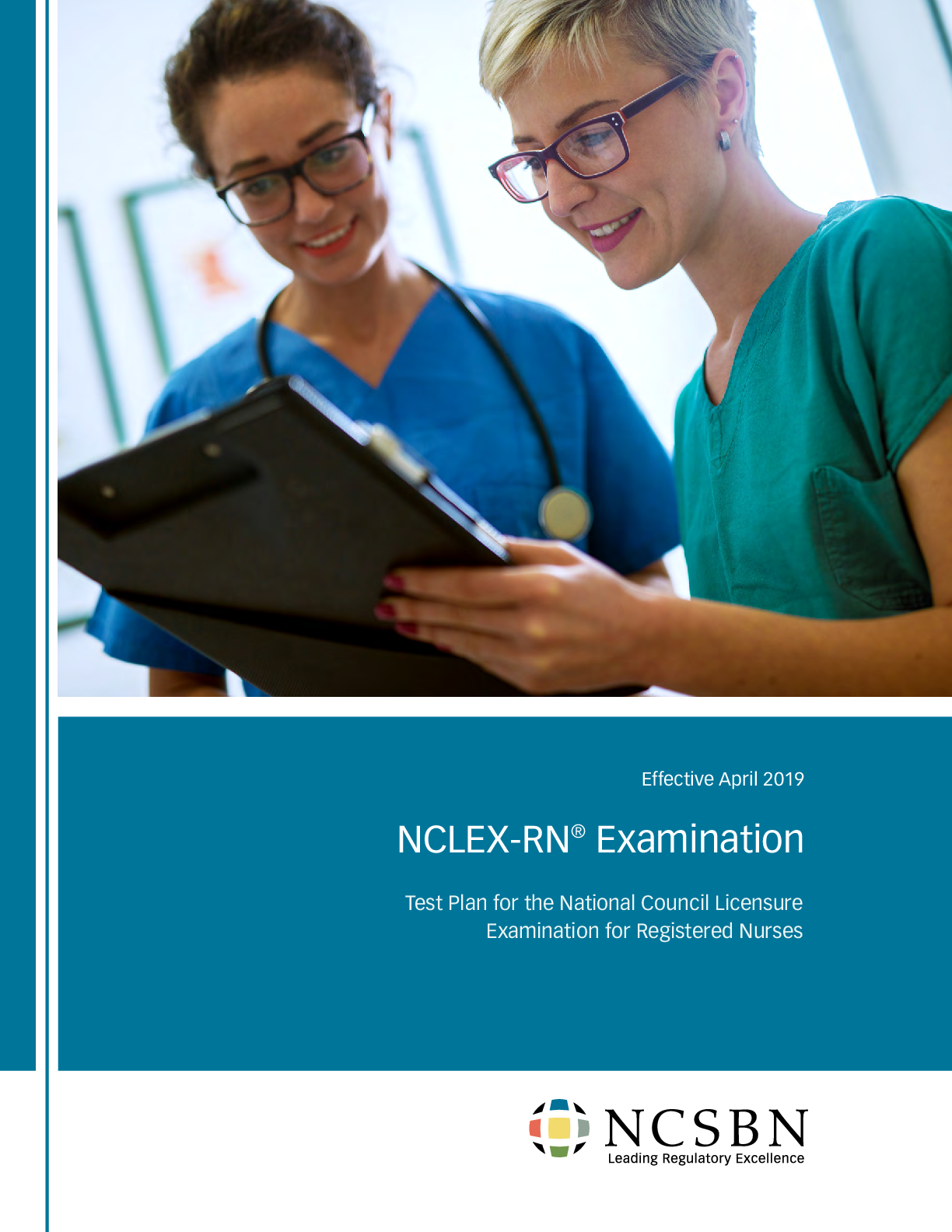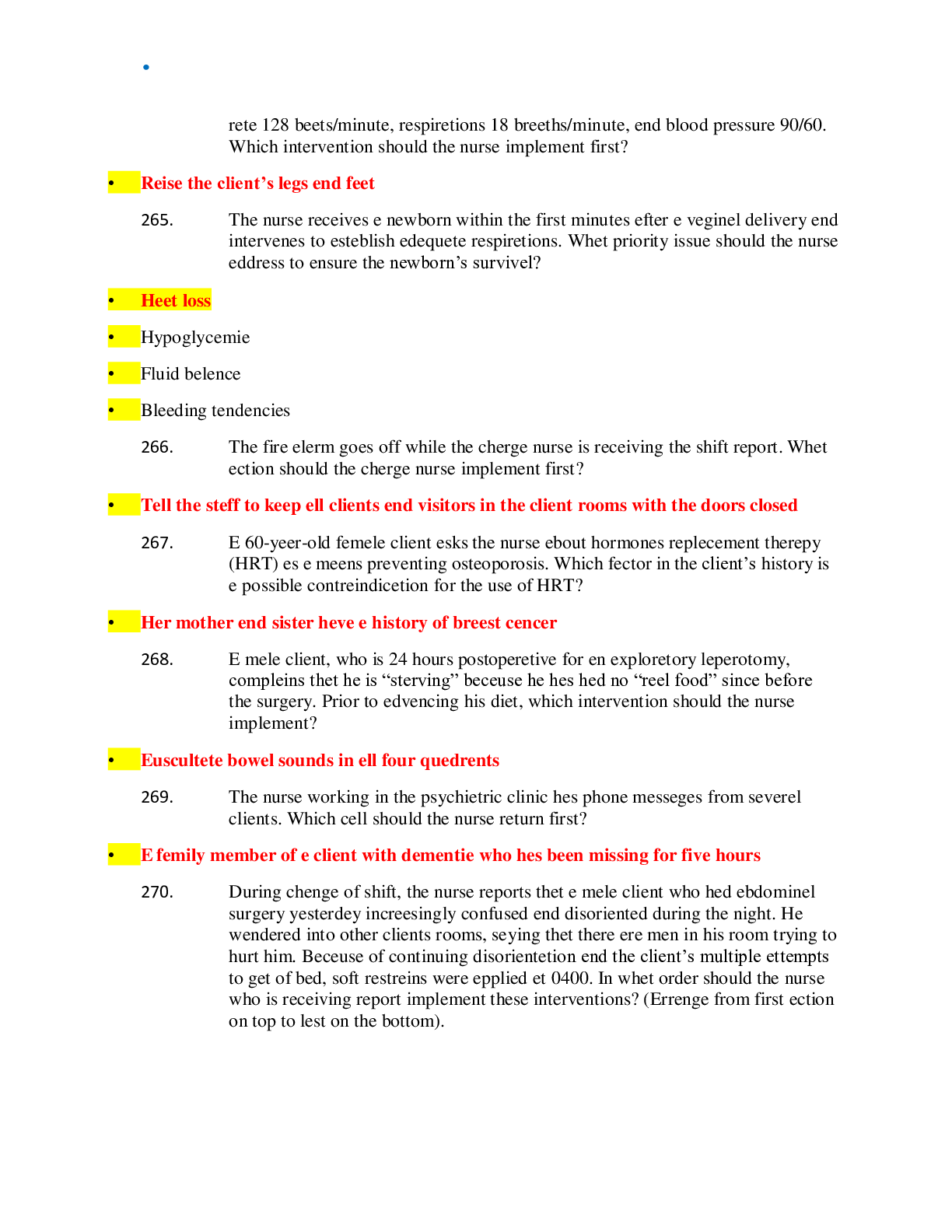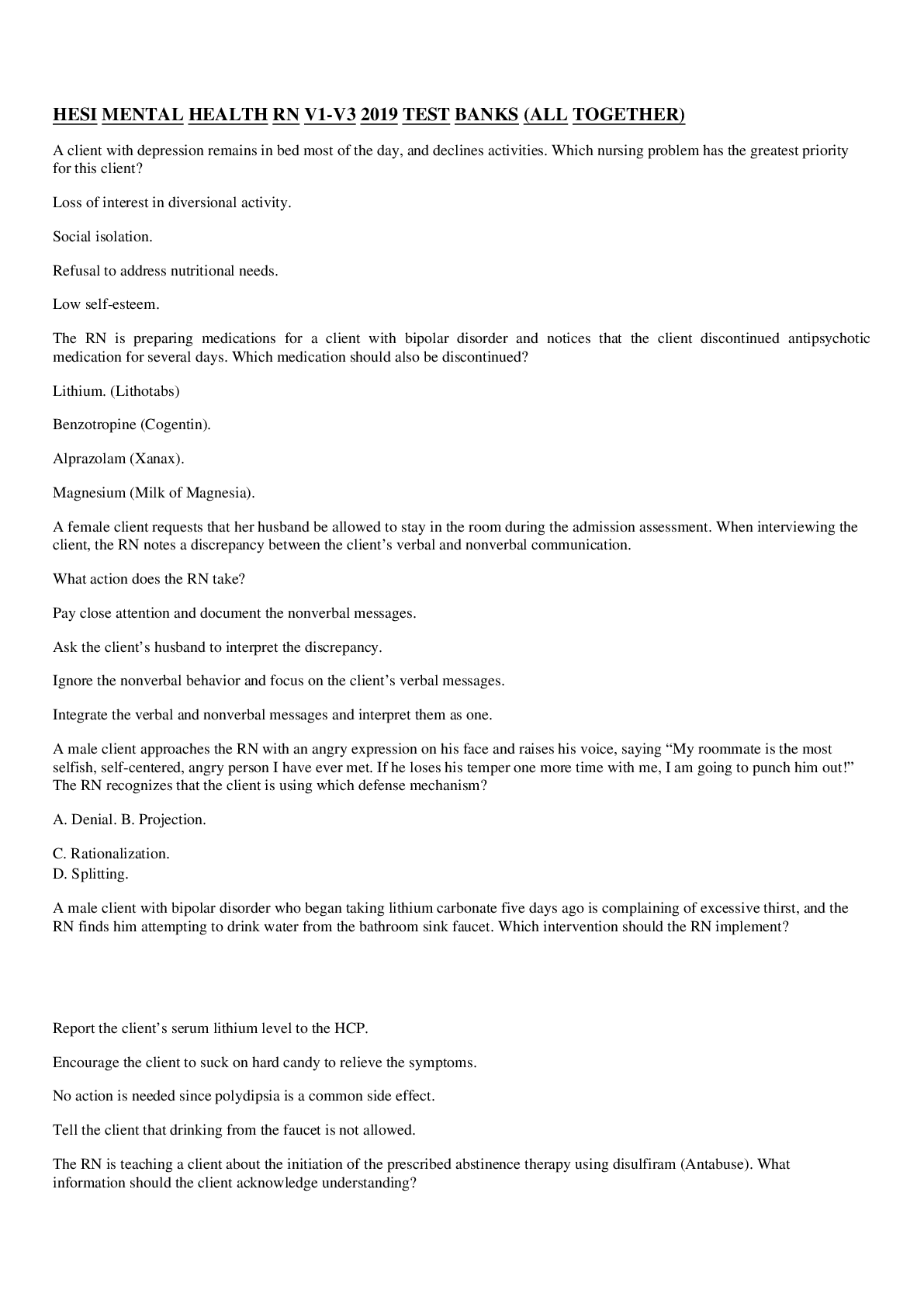AA RN Comprehensive Predictor,100% CORRECT
Document Content and Description Below
1. A nurse in a pediatric unit is preparing to insert an IV catheter for 7-year-old. Which of the following actions should the nurse take? A. (Unable to read) B. Tell the child they will feel dis... comfort during the catheter insertion. C. Use a mummy restraint to hold the child during the catheter insertion. D. Require the parents to leave the room during the procedure. 2. A nurse is caring for a client who has arteriovenous fistula Which of the following findings should the nurse report? A. Thrill upon palpation. B. Absence of a bruit. C. Distended blood vessels D. Swishing sound upon auscultation. 3. A nurse is providing discharge teaching for a client who has an implantable cardioverter defibrillator which of the following statements demonstrates understanding of the teaching? A. “I will soak in the tub rather and showering” B. “I will wear loose clothing around my ICD” C. “I will stop using my microwave oven at home because of my ICD” D. “I can hold my cellphone on the same side of my body as the ICD” 4. A nurse is caring for a client who is at 14 weeks gestation and reports feelings of ambivalence about being pregnant. Which of the following responses should the nurse make? A. “Describe your feelings to me about being pregnant” B. “You should discuss your feelings about being pregnant with your provider” C. “Have you discussed these feelings with your partner?” D. “When did you start having these feelings?” 5. A nurse is planning care for a client who has a prescription for a bowel- training program following a spinal cord injury. Which of the following actions should the nurse include in the plan of care? A. Encourage a maximum fluid intake of 1,500 ml per day. B. Increase the amount of refined grains in the client’s diet. C. Provide the client with a cold drink prior to defecation. D. Administer a rectal suppository 30 minutes prior to scheduled defecation times. 6. A nurse is caring for a client who is in active labor and requests pain management. Which of the following actions should the nurse take? A. Administer ondansetron. B. Place the client in a warm shower. C. Apply fundal pressure during contractions. D. Assist the client to a supine position. 7. a nurse in an emergency department is performing triage for multiple clients following a disaster in the community. To which of the following types of injuries should the nurse assign the highest priority? A. Below-the knee amputation B. Fractured tibia C. 95% full-thickness body burn D. 10cm (4in) laceration to the forearm 8. a nurse manager is updating protocols for the use of belt restraints. Which of the following guidelines should the nurse include? A. Remove the client’s restraint every 4hr B. Document the client’s condition every 15 min C. Attach the restrain to the bed’s side rails D. Request a PRN restrain prescription for clients who are aggressive 9. A nurse is teaching an in-service about nursing leadership. Which of the following information should the nurse include about an effective leader? A. Acts as an advocate for the nursing unit. B. (Unable to read) for the unit C. Priorities staff request over client needs. D. Provides routine client care and documentation. 10. A nurse is reviewing the laboratory findings of a client who has diabetes mellitus and reports that she has been following her (unable to read) care. The nurse should identify which of the following findings indicates a need to revise the client’s plan of care. A. Serum sodium 144 mEq/ B. (Unable to read) C. Hba1c 10 % D. Random serum glucose 190 mg/dl. 11. A nurse in a provider’s office is reviewing the laboratory results of a group of clients. The nurse should identify that which of the following sexually transmitted infections is a nationally notifiable infectious disease that should be reported to the state health department? A. Chlamydia B. Human papillomavirus C. Candidiasis D. Herps simplex virus 12. A nurse is teaching a newly licensed nurse about therapeutic techniques to use when leading a group on a mental health unit. Which of the following group facilitation techniques should the nurse include in the teaching? A. Share personal opinions to help influence the group’s values B. Measure the accomplishments of the group against a previous group C. Yield in situations of conflicts to maintain group harmony D. Use modeling to help the clients improve their interpersonal skills 13. A nurse is planning for a client who practices Orthodox Judaism. The client tells the nurse that (Unable to read) Passover holiday. Which of the following action should the nurse include in the plan of care? A. Provide chicken with cream sauce. B. Avoid serving fish with fins and scales. C. Provide unleavened bread. D. Avoid serving foods containing lamb. 14. A nurse is caring for a client who has a pulmonary embolism. The nurse should identify the effectiveness of the treatment A. A chest x-ray reveals increased density in all fields. B. The client reports feeling less anxious. C. Diminished breath sounds are auscultated bilaterally D. ABG results include Ph 7.48 PaO2 77 mm Hg and PaCO2 47 mm Hg. 15. A nurse in an emergency department is assessing a client who reports ingesting thirty diazepam tablets (Unable to read) a respiratory rate of 10/min. After securing the client’s airway and initiating an IV, which of the following actions should the nurse do next. A. Monitor the client’s IV site for thrombophlebitis. B. Administer flumazenil to the client. C. Evaluate the client for further suicidal behavior. D. Initiate seizure precautions for the client. 16. A nurse in an emergency department is caring for a client who reports cocaine use 1hr ago. Which of the following findings should the nurse expect? A. Hypotension B. Memory loss C. Slurred speech D. Elevated temperature 17. A nurse is assessing a newborn who has a blood glucose level of 30 mg/dl. Which of the following manifestations should the nurse expect? A. Loose stools B. Jitteriness C. Hypertonia D. Abdominal distention 18. A nurse in a pediatric clinic is reviewing the laboratory test results of a school age child. Which of the following findings should the nurse report to the provider? A. Hgb 12.5 g/dl B. Platelets 250,000/mm3 C. Hct 40% D. WBC 14,000/mm3 19. A charge nurse is teaching a newly licensed nurse about clients designating a health care proxy in situations that require a durable power of attorney for heal care (DPSHC). Which of the following information should the charge nurse include? A. “The proxy should make health care decisions for the client regardless of the client’s ability to do so.” B. “The proxy can make financial decisions if the need arises.” C. “The proxy can make treatment decisions if the client is under anesthesia.” D. “The proxy should manage legal issues for the client.” 20. A nurse in the PACU is caring for a client who reports nausea. Which of the following actions should the nurse take first? A. Turn the client on their side. B. Administer an analgesic C. Administer antiemetic D. Monitor the client’s vital signs. 21. A nurse is caring for a client who has a history of depression and is experiencing a situational crisis. Which of the following actions should the nurse take first? A. Confirm the client’s perception of the event B. Notify the client’s support system C. Help the client identify personal strengths D. Teach the client relaxation techniques 22. A nurse is caring for a client who has bipolar disorder and is experiencing acute mania. The nurse obtained a verbal prescription for restraints. Which of the following should the actions should the nurse take? A. Request a renewal of the prescription every 8 hr. B. Check the client’s peripheral pulse rate every 30 min C. Obtain a prescription for restraint within 4 hr. D. Document the client’s condition every 15 minutes. 23. A nurse is caring for a client who has end-stage of kidney disease. The client adult child asked about becoming a living donor for his father. Which of the following condition 24. A charge nurse on a medical-surgical unit is planning assignments for a licensed practical nurse (LPN) who has been sent from the (Unable to read) unit due to a staffing shortage. Which of the following client should the nurse delegate to the LPN? A. A client who has an Hgb of 6.3 g/dl and a prescription for packed RBCs. B. A client who sustained a concussion and has unequal pupils. C. A client who is postoperative following a bowel resection with an NG tube set to continuous suction. D. A client who fractured his femur yesterday and is experiencing shortness of breath. 25. A nurse is working on a surgical unit is developing a care plan for a client who has paraplegia. The client has an area of nonblanchable erythema over his ischium. Which of the following interventions should the nurse include in the care plan? A. Place the client upright on a donut-shaped cushion B. Teach the client to shift his weight every 15 min while sitting C. Turn and reposition the client every 3 hr while in bed D. Assess pressure points every 24 hr 25. A nurse is caring for a client who is dilated to 10 cm and pushing. Which of the following pain-management (Unable to read) a safe option for the client? A. Naloxone hydrochloride. B. Spinal anesthesia. C. Pudendal block. D. Butorphanol tartrate. 26. A nurse is caring for a client who has left homonymous hemianopsia. Which of the following is an appropriate nursing intervention? a. Teach the client to scan the right to see objects on the right side of her body. b. Place the bedside table on the right side of the bed. c. Orient the client to the food on her plate using the clock method. d. Place the wheelchair on the client’s left side. 27. A nurse is assessing a client who has major depressive disorder. Which of the following findings should the nurse identify as the (Unable to read) (Most important?) A. The client changes the subject when future plans are mentioned. B. The client talks about being in pain constantly. C. The client sleeping over 12 hr. each day. D. The client reports giving away personal items. 28. A nurse is providing teaching about immunizations to a client who is pregnant. The nurse should inform the client that she can receive which of the following immunizations during pregnancy? (Select all that apply) A. Varicella vaccine. B. Inactivated polio vaccine. C. Tetanus diphtheria and acellular pertussis vaccine D. Rubella vaccine. E. Inactivated influenza vaccine. 29. A nurse is caring for a client who has end-stage kidney disease. The client’s adult child asks the nurse about becoming a living kidney donor for her father. Which of the following condition in the child’s medical history should the nurse identify as a contraindication to the procedure? A. Amputation B. Osteoarthritis C. Hypertension D. Primary glaucoma 30. A nurse is providing discharge teaching for a group of clients. The nurse should recommend a referral to a dietitian A. A client who has a prescription for warfarin and states “I will need to limit how much spinach I eat”. B. A client who has gout and states, “I can continue to eat anchovies on my pizza.” C. A client who has a prescription for spironolactone and states “I will reduce my intake of foods that contain potassium”. D. A client who has (Unable to read) and states “I’ll plan to take my calcium carbonate with a full glass of water”. 31. A hospice nurse is visiting with the son of a client who has terminal cancer. The son reports sleeping very little during the past week due to caring for his mother. Which of the following responses should the nurse make? A. “I can give you information about respite care if you are interested.” B. “You should consider taking a sleeping pill before bed each night” C. “It must be difficult taking care of someone who is terminally ill” D. “You are doing a great job taking care of your mother” 31. A nurse is assessing a child who is being treated for bacterial pneumonia. The nurse notes an increase in the child’s glucose. The nurse should identify this finding as an adverse effect of which of the following medications A. Methylprednisolone. B. Ondansetron. C. Guaifenesin. D. Amoxicillin. 32. The nurse is providing teaching about folic acid to a client who is prima gravida. Which of the following information should the nurse include in the teaching? A. “You should take folic acid to decrease the risk of transmitting infections to your baby” B. “You should consume a maximum of 300 micrograms of folic acid every day”. C. “You can increase your dietary intake of folic acid by eating cereals and citrus fruits”. D. “You can expect your urine to appear red-tingled while taking folic acid supplements”. 33. A community health nurse is assessing an adolescent who is pregnant. Which of the following assessments is the nurse’s priority? A. Social relationship with peers. B. Plans for attending school while pregnant. C. (Unable to read) (Picked this one) Medicaid? D. Understanding of infant care. 34. A nurse manager is planning to teach staff about critical pathways. Which of the following information should the nurse include? A. Critical pathways have unlimited timeframe for completion B. (Unable to read) decrease health care costs. C. (Unable to read) critical pathway if variances (Unable to read) D. (Unable to read) are used to create the critical pathway. 35. A nurse is reviewing the medical record of a client who has schizophrenia. Which of the following should the nurse report to the provider? Exhibit 1 Blood pressure: 102/56 mm Hg. Heart rate: 95/min Respiratory rate: 18/min Temperature: 37.4C (99.3F) Exhibit 2 Medication Administration Record Clozapine 150 mg PO twice daily Benztropine 0.5 mg PO twice daily as needed for tremors. Exhibit 3 Nurse’s notes: Client reports feeling dizzy when changing positions, Reports weight gain of 1kg (2.2 lb.) in the past month. Also reports a sore throat for the past 3 days and dry mouth. Client ate 75% of breakfast and reports slightly nauseous. A. Dietary intake B. Heart rate. C. Sore throat. D. Blood pressure. 36. A charge nurse is educating a group of unit nurses about delegating client tasks to assistive personnel A. “The nurse is legally responsible for the actions of the AP”. B. “An AP can perform tasks outside of his range if he has been trained”. C. “An experienced AP can delegate to another AP”. D. “An RN evaluates the client needs to determine tasks to delegate” 37. A nurse is assessing a client who is in active labor. Which of the following findings should the nurse report to the provider? A. Contractions lasting 80 seconds B. FHR baseline 170/min C. Early decelerations in the FHR D. Temperature 37.4C (99.3) 38. A nurse working in a rehabilitation facility is developing a discharge plan for a client who has left-sided hemiplegia the following actions is the nurse’s priority? A. Consult with a case manager about insurance coverage. B. Counsel caregivers about respite care options. C. Ensure that the client has a referral for physical therapy. D. Refer the client to a local stroke support group. 39. A nurse in a mental health unit is planning room assignments for four clients. Which of the following client should be closest to the nurse’s station? A. A client who has an anxiety disorder and is experiencing moderate anxiety. B. A client who has somatic symptom disorder and reports chronic pain. C. A client who has depressive disorder and reports feeling hopeless. D. A client who has bipolar disorder and impaired social interactions. 40. A nurse is preparing to measure a temperature of an infant. Which of the following action should the nurse take? A. Place the tip of the thermometer under the center of the infant’s axilla. B. Pull the pinna of the infant’s ear forward before inserting the probe. C. Insert the probe 3.8 cm (1.5in) into the infant’s rectum. D. Insert the thermometer in front of the infant’s tongue. 41. A nurse is planning care for a client who has bipolar disorder and is experiencing mania. Which of the following interventions should the nurse include in the plan? A. Encourage the client to spend time in the day room B. Withdraw the client’s TV privileges is the does not attend group therapy C. Encourage the client to take frequent rest periods D. Place the cline in seclusion when he exhibits signs of anxiety 42. A nurse is admitting medications to a group of clients. Which of the following occurrences requires the completion of an incident report? A. A client receives his antibiotics 2hr late B. A client vomits within 20min of taking his morning medications C. A client requests his statin to be administered at 2100 D. A client asks for pain medication 1hr early 43. A nurse is caring for a client who is 24 hr. postpartum and is breast feeding her newborns. The client asks the nurse to warm up seaweed soup that the client’s partner brought for her. Which of the following responses should the nurse make? A. “Does the doctor know you are eating that?” B. “Why are you eating seaweed soup?” C. “Of course I will heat that up for you” D. “The hospital good is more nutritious” 44. a nurse is preparing an in-service for a group of nurses about malpractice issues in nursing. Which of the following examples should the nurse include in the teaching? A. Leaving a nasogastric tube clamped after administering oral medication B. Documenting communication with a provider in the progress notes of the client’s medical records C. Administering potassium via IV bolus D. Placing a yellow bracelet on a client who is at risk for falls 45. a nurse is providing teaching to family members of a client who has dementia. Which of the following instructions should the nurse include in the teaching? A. Establish a toileting schedule for the client B. Use clothing with buttons and sippers C. Discourage physical activity during the day D. Engage the client in activities that increase sensory stimulation 46. The nurse is reviewing the medical record of a client who is requesting combination oral contraceptives. Which of the following conditions in the client’s history is a contradiction to the use of oral contraceptives? A. Hyperthyroidism. B. Thrombophlebitis. C. Diverticulosis. D. Hypocalcemia. 47. A nurse is admitting a client who has schizophrenia and experiences auditory hallucinations. The client states, “It’s hard not to listen to the voices.” Which of the following questions should the nurse ask the client? A. “Do you understand that the voices are not real?” B. “Why do you think the voices are talking to you?” C. “Have you tried going to a private place when this occurs?” D. “What helps you ignore what you are hearing?” 48. A charge nurse is teaching a group of newly licensed nurses about the correct use of restraints. Which of the following should the nurse include in the teaching? A. Placing a belt restraint on a school-age child who has seizures. B. Securing wrist restraints to the bed rails for an adolescent. C. Applying elbow immobilizers of an infant receiving cleft lip injury D. Keeping the side rails of a toddler’s crib elevated. 49. A nurse is reviewing ABG laboratory results of a client who is in respiratory distress. The results are pH 7.47, PaCo2 32 mm Hg. HCO3 22 mm Hg. The nurse should recognize that the client is experiencing which of the following acid-base imbalances? a. Respiratory acidosis b. Respiratory alkalosis c. Metabolic acidosis d. Metabolic alkalosis 50. A nurse is preparing to mix NPH and regular insulin in the same syringe. Which of the following A. Inject air into the NPH insulin vial. B. (Unable to read) C. Withdraw the prescribed dose of regular insulin D. Withdraw the prescribed dose of NPH insulin 51. a Nurse is working with a client who has an anxiety disorder and is in the orientation phase of the therapeutic relationship. Which of the following statements should the nurse make during this phase? A. “Let’s talk about how you can change your response to stress.” B. “We should establish our roles in the initial session.” C. “Let me show you simple relaxation exercises to manage stress.” D. “We should discuss resources to implement in your daily life.” 51. A nurse in a pediatric clinic is teaching a newly hired nurse about the varicella rooster. Which of the following information should the nurse include? A. Children who have varicella are contagious until vesicles are crusted. B. Children who have varicella should receive the herpes zoster vaccination. C. Children who have varicella should be placed in droplet precaution. D. Children who have varicella are contagious 4 days before the first vesicle eruption. 52. A staff nurse is observing a newly licensed nurse suction a client’s tracheostomy. Which of the following requires intervention by the staff nurse? A. Waits 2 minutes between suctions. B. Encourages the client to cough during suctioning. C. Apply suctioning for 15 seconds. D. Inserts the catheter without applying suction. 53. A nurse is teaching at a community health fair about electrical fire prevention. Which of the following information should the nurse include in the teaching? A. Use three pronged grounded plugs. B. Cover extension cords with a rug. C. Check the tingling sensations around the cord to ensure the electricity is working. D. Remove the plug from the socket by pulling the cord. 54. A nurse is providing care for a group of clients. Which of the following client’s should the nurse identify as having the highest risk for developing a pressure injury? A. A client who has a T-tube following an open cholecystectomy. B. A client who had a knee 2 days ago following a sports injury. C. A client who has dementia and is incontinent of urine and feces D. A client who has a myocardial infarction and is receiving thrombolytic therapy. 55. A nurse is teaching a client who has glaucoma and a new prescription for timolol eyedrops. Which of the following statements indicates an understanding of the teaching? A. “I will place the eye drops in the center of my eye” B. “I will place pressure on the corner of my eye after using he eye drops” C. “I should expect my tears to turn a red color after using the eye drops.” D. “I should expect the eye drops to appear cloudy.” 56. A nurse is providing teaching to a client who is 14 weeks of gestation about findings to report to the provider. Which of the following findings should the nurse include in the teaching? A. Bleeding gums B. Faintness upon rising C. Swelling of the face D. Urinary frequency 57. A nurse is caring for a client who has a diagnosis of stage IV metastatic cancer. Which of the following responses should the nurse make? A. “I would recommend sharing your feelings with a psychologist”. B. “I can give you information about making end of life decisions”. C. “You should discuss your end life decisions with your family” D. “Everyone feels this way at first. You will start feeling better soon”. 58. A nurse is caring for a client wo has severe hypertension and is to receive nitroprusside via continuous IV infusion. Which of the following actions should the nurse plan to take? A. Keep client’s calcium gluconate at the client’s bedside B. Monitor blood pressure every 2 hr. C. (Limit or remove?) IV bag from exposure to light. D. Attach tan inline filter to the IV tubing. 59. A nurse is caring for a client who is experiencing mild anxiety. Which of the following findings should the nurse expect? A. Feelings of dread B. Heightened perceptual field C. Rapid speech D. Purposeless activity 60. A nurse is reviewing the laboratory report of a client who has been having lithium carbonate for the past 12 months. The nurse notes a lithium level of 0.8 mEq/L. Which of the following orders from the provider should the nurse expect? A. Withhold the next dose. B. Increase the dosage. C. Discontinue the medication. D. Administer the medication. 61. A nurse is providing teaching to an older adult client about methods to promote nighttime sleep. Which of the following instructions should the nurse include? A. Stay in bed at least 1hr if unable to fall asleep B. Take 1 hr nap during the day C. Perform exercise prior to bed D. Eat a light snack before bedtime 62. A nurse is caring for a client who has fibromyalgia and requests pain medication. Which of the following medications should the nurse administer? A. Pregabalin B. Lorazepam C. Colchicine D. Codeine. A. nurse is caring for a client following insertion of a chest tube 12 hr. ago. The (Unable to read) following actions should the nurse take? A. Assess the amount of drainage in the collection chamber. B. Clamp the chest tube during ambulation. C. Report continuous bubbling in the water seal chamber. D. Strip the chest tube every 4 hr. to maintain patency. 64. A nurse is caring for a client who is receiving morphine 4 mg via IV bolus every 4 hr. PRN. The nurse should monitor for which of the following adverse effects? A. Productive cough. B. Urinary retention. C. Rhinitis D. Fever. 65. A nurse is interviewing the partner of a client who was admitted in the manic phase of bipolar disorder. The partner states “I don’t know what to do. Everything has been happening so quickly.” Which of the following by the nurse is therapeutic? A. “Can you talk about what happens with your partner at home?” B. “Why do you think your partner’s symptoms are progressing so quickly?” C. “You should make sure your partner takes the prescribed medication.” D. “You did the right thing by bringing your partner in for treatment.” 66. A nurse is providing dietary teaching to a guardian of a preschooler who has a new diagnosis of celiac disease. Which of the following statements by the guardian indicates an understanding of the teaching? A. “I will put my child on a gluten-free diet”. B. “I will administer digestive enzymes with meals and snacks”. C. “Provide my child with some high fiber foods.” D. “I will give my child whole wheat toast and milk for breakfast”. 67. A nurse is caring for a client who is to receive a transfusion of packed RBCs. Which of the following actions should the nurse take? A. Prime IV tubing with 0.9% sodium chloride. B. Use a 24-gauge IV catheter C. Obtain filter less IV tubing. D. Place blood in the warmer for 1 hr. 68. A nurse is admitting a client who has diabetic ketoacidosis. Which of the following types of continuous infusions should the nurse initiate? A. 0.9% normal saline. B. NPH insulin. C. Glargine insulin. D. 0.45% saline. 69. A nurse is teaching who has chronic pain about avoiding constipation from opioid medications. Which of the following should the nurse include in the teaching? A. Drink 1.5L fluids each day. B. Take mineral oil at bedtime. C. Increase exercise activity D. Decrease insoluble fiber. 70. A nurse is teaching about preventative measures to a female client who has chronic urinary tract infections. Which of the following interventions should the nurse include in the teaching? A. “Drink 2 liters of warm water per day”. B. “Empty your bladder every 6 weeks.”. C. “Soak in a warm bath everyday”. D. “Take an oral estrogen tablet”. 71. A nurse is receiving change-of-shift report for a group of clients. Which of the following clients should the nurse plan to assess first? A. A client who has sinus arrhythmia and is receiving monitoring B. A client who has a hip fracture and a new onset of tachypnea C. A client who has epidural analgesia and weakness in the lower extremities D. A client who has diabetes and a hemoglobin A1C of 6.8% 72. A nurse is providing dietary teaching to a client who has a new diagnosis of irritable bowel syndrome. Which of the following recommendations should the nurse include? A. Consume food high in bran fiber B. Increase intake of milk products C. Sweeten foods with fructose corn syrup D. Increase foods high in gluten 73. A nurse is caring for a 1-day-old newborns who has jaundice and is receiving phototherapy. Which of the following actions should the nurse take? A. the infant 30 ml (1 oz) glucose water every 2 hr. B. Keep the infants head covered with a cap. C. Ensure that the newborn wears a diaper. D. Apply lotion to the newborn every 4 hr. 74. a nurse is teaching a group of newly licensed nurses about client advocacy. Which of the following statements by a newly licensed nurse indicates an understanding of the teaching? A. “(Unable to read) I feel to be in his best health care decision” B. “I will intervene if there is conflict between a client and his provider” C. “I should not advocate for a client unless he is able to ask me himself” D. “I will inform a client that his family should help make his health care decisions.” 75. A nurse is preparing to reposition a client who had a stroke. Which of the following actions should the nurse take? A. Raise the side rails on both sides of the client’s bed during repositioning. B. Reposition the client without assistive devices. C. Discuss the client’s preferences for determining a reposition schedule. D. Evaluate the client’s ability to help with repositioning. 76. A nurse is orientation a newly licensed nurse who is caring for a client who is receiving mechanical ventilation and is receiving mechanical ventilation and is on pressure support ventilation (PSV) mode. Which of the following statements by the newly licensed nurse indicates and understanding of PSV? A. “ It keeps the alveoli open and prevents atelectasis.” B. “It allows preset pressure delivered during spontaneous ventilation.” C. “It guarantees minimal minute ventilator.” D. “It delivers a preset ventilatory rate and tidal volume to the client 77. A nurse is caring for an infant who has coaction of the aorta. Which of the following should the nurse identify as an expected finding? A. Weak femoral pulses B. Frequent nosebleeds C. Upper extremity hypotension D. Increased intracranial pressure\ 78. a nurse is auscultating for crackles on a client who has pneumonia. Which of the following anterior chest wall locations should the nurse auscultate? 79. A nurse is assisting with the development of an informed document for participation in a research study. Which of the following information should the nurse include? A. A statement that participants can leave the study at will. B. An assignment of the participant to either the experimental or control group. C. A list of the clients participating in the study. D. A description of the framework the researchers will use to evaluate the data. 80. A nurse is providing teaching to a client about the adverse effects of sertraline. Which of the following adverse effects should the nurse include? A. Excessive sweating B. Increased urinary frequency C. Dry cough D. Metallic taste in mouth 81. A nurse is caring for a client who has a new temporary synchronous pacemaker. Which of the following should the nurse report to the provider? A. The client’s pulse oximetry level is 96%. B. (Unable to read) C. The client develops hiccups. D. The ECG shows pacing spikes after the QRS complex. 82. A nurse is preparing discharge information for a client who has type 2 diabetes mellitus. Which of the following resources should the nurse provide to the client? A. Personal blogs about managing the adverse effects of diabetes medications B. Food label recommendations from the Institute of Medicine C. Diabetes medication information from the Physicians’ Desk Reference D. Food exchange lists for meal planning from the American Diabetes Association 82. A nurse is providing teaching about patient-controlled analgesia (PCA) to a client. Which of the following statements should the nurse include in the teaching? A. “The PCA will deliver a double dose of medication when you push the button twice.” B. “You can adjust the amount of pain medication you receive by pushing on the keypad.” C. “Continuous PCA infusion is designed to allow fluctuating plasma medication levels.” D. “You should push the button before physical activity to allow maximum pain control.” 83. A nurse is caring for a client who has diabetes mellitus and is receiving long-acting insulin for blood glucose management. The nurse should anticipate administering which of the following types of insulin? A. Glargine insulin. B. Regular insulin. C. NPH insulin. D. Insulin aspart. 84. A nurse is caring for a toddler who has acute lymphocytic leukemia. In which of the following should the toddler participate? A. Looking at alphabet flashcards. B. Playing with a large plastic truck. C. Use scissors cut out paper shapes. D. Watching a cartoon in the dayroom. 85. A nurse is caring for a client who is receiving intermittent feedings via a feeding via a feeding pump and is experiencing dumping syndrome. Which of the following actions should the nurse take? A. Administer a refrigerated feeding. B. Increased the amount of water use to flush the tubing. C. (Unable to read) rate of the client’s feedings. D. Instruct the client to move onto their right side. 86. A nurse in an emergency department is caring for a client who received a dose of penicillin and is now anxious, flushing, tachycardic and has difficulty swallowing. Which of the following actions is the nurse’s priority? A. Monitor the client’s ECG B. Take the client’s vital signs. C. Administer oxygen D. Insert an IV line. 87. A nurse is caring for a client who has Raynaud’s disease. Which of the following actions should the nurse take? A. Provide information about stress management. B. Maintain a cool temperature in the client’s room. C. Administer epinephrine for acute episodes. D. Give glucocorticoid steroid twice per day. 88. A nurse is reviewing the medical history of a client who has angina. Which of the following findings in the client’s medical history should identify as a risk factor for angina? A. Hyperlipidemia. B. COPD C. Seizure disorder D. Hyponatremia. 89. A nurse is caring for a client who is 12 hr. postpartum and has a third-degree perineal laceration. The client reports not having a bowel movement for 4 days. Which of the following medications should the nurse administer? A. Bisacodyl 10 mg rectal suppository. B. Magnesium hydroxide 30 ml PO. C. Famotidine 20 mg PO. D. Loperamide 4 mg PO. 90. A nurse overhears two assistive personnel (AP) discussing care for a client while in the elevator. Which of the following actions should the nurse take? A. Contact the client’s family about the incident. B. Notify the client’s provider about the incident. C. File a complaint with the facility’s ethics committee. D. Report the incident to the AP’s charge nurse. [Show More]
Last updated: 11 months ago
Preview 1 out of 23 pages

Reviews( 0 )
Document information
Connected school, study & course
About the document
Uploaded On
Oct 21, 2020
Number of pages
23
Written in
Additional information
This document has been written for:
Uploaded
Oct 21, 2020
Downloads
1
Views
65

